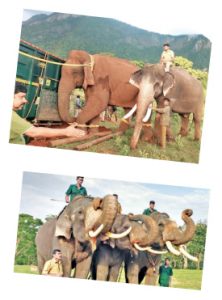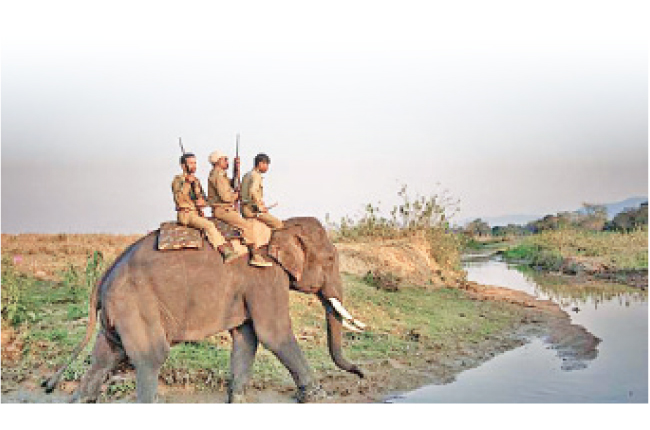The practice of capturing wild Asian elephants and then taming and training them for work originated approximately 4000 years ago. Originally used as war elephants on battlefields, they came to be used extensively as draught animals in the logging of forests, in timber yards, in clearing land for development and in temples.The Matangaleela, a rendition of the Gajashastra, by the Sanskrit poet Nilakanta, talks of five different techniques that can be used for capturing elephants— stockades; using female elephants as bait; noosing the elephant; following the animal till it tires out and then restraining it; placing a noose in a small pit and attracting the elephant to the pit using food.
Realms have been written about suggestions to mitigate the human-elephant crisis in Sri Lanka. Many human lives have been lost, and also the lives of elephants. This narrative is based on studying the Kumki elephant system, successfully used in India. “Kumki” comes from the Persian word “kumak,” which means “aid.This method can be adapted by the Wildlife Department in Sri Lanka. We have a rich heritage of our own mahouts and many famous tuskers. After all what better method to use than a trained elephant to confront, control and chase away intruding dangerous wild elephants who dominate villages bordering our forests.
Kumki
Kumki is a term used in India for trained captive Asian elephants used in operations to trap wild elephants, sometimes to rescue or to provide medical treatment to an injured wild elephant.Kumkis are used for capturing, calming and herding wild elephants or to lead wild elephants away in conflict situations. Kumki elephants are prepared elephants utilised in India for different preservation and natural life the board purposes, including moderating human-natural life struggle and directing wild elephants from human settlements.
Kumki elephants are elephants trained to capture and tame wild elephants. Elephant calves that are separated from the herd in the forest and captured wild elephants are tamed and trained to become Kumki elephant, the training takes 3 years. Kumki elephants are important resources in protection for assignments like directing wild elephants to more secure regions or limiting struggles. Preservation approaches focus on the security of both natural life and human networks in a reasonable way.When wild elephants create chaos, frighten people in inhabited areas, the forest department deploys kumkis who are trained elephants to tame other wild elephants to keep the animal and humans safe.
 Most elephant management, in the wild and in captivity, does not take the animal’s biology, physiology, or behaviour into consideration. The elephant, with its well-developed forebrain, is known to display emotions, possess human-like features such as self-recognition in mirrors and engage in cooperative problem-solving. A comprehensive understanding of all these traits is imperative for managing elephants in captivity and advanced training.
Most elephant management, in the wild and in captivity, does not take the animal’s biology, physiology, or behaviour into consideration. The elephant, with its well-developed forebrain, is known to display emotions, possess human-like features such as self-recognition in mirrors and engage in cooperative problem-solving. A comprehensive understanding of all these traits is imperative for managing elephants in captivity and advanced training.
Kumki elephants can be deployed strategically to manage and drive wild elephants thereby reducing damage to crops, human habitations and the potential loss of both human and elephant lives. These elephants can serve as an invaluable asset to the State’s wildlife organisation, by helping in minimising the conflicts and safeguarding both human and wildlife interests.In recent times, increasing political pressure and public agitation have necessitated the removal of elephants from conflict zones. Such captures and relocation are part of the larger debate about elephant conservation.
Training
Following capture, the training methods used vary greatly depending on geographical location and local practices—from extremely harsh negative reinforcement to more humane positive reinforcement or rewards-based training. The training could be ‘open’ – direct contact between the restrained elephant and the trainer/mahout) or ‘closed’ – the animal is kept inside the kraal [wooden enclosure] till the training is complete.Gajashastra discusses the techniques to be followed while training an elephant; it lists commands, training protocols, and more importantly, the character of the mahout.
The traditional way of training an elephant involves establishing dominance through various methods. Forceful submission—the most common of these—has drawn some criticism.In the closed training system, the elephant is confined within a standard kraal. The floors of the kraals are made of wooden slats with gaps in between that prevent them from becoming damp. The roof is made of tiles. A large drum of water is provided. The approach of the mahout is similar—they use the same vocal and tactile commands and employ a mixture of positive reinforcement/rewards-based training.
The first step is usually familiarisation with the mahout’s voice, which is done through repeated verbal commands. Initially, a captured wild elephant will display aggressive behaviour, resistance and it will try to hit the wooden bars of the kraal. A raised voice, or a sudden dominance gesture by the mahout, usually prevents this. Once the elephant starts responding to the mahout positively, it begins to use its trunk to accept food .Usually in about 10 days, the animal would have started to accept the mahout and take food directly from his hand. About a week later, after the mahout has further established his relationship with the elephant, he will enter the kraal to tend to any bruises or abrasions incurred during the capture.
In captivity, an animal that is given opportunities to learn on its own becomes relatively easier to manage. For instance, animals rescued as very young calves (one year or less) and brought into captivity often have difficulty grazing or browsing in the wild as adults, as they have become accustomed to subsisting on cut fodder in their stalls and have not learnt to graze freely. This occurs less in forest camp settings, where there is a social network and adult females foster and teach the young ones.
While kraal training involves establishing a relationship with the animal and the elephant listening to the vocal and tactile commands of the mahout, it is important to have follow-up sessions for the elephant and its mahout to bond more deeply. Initially, the mahout will establish a daily routine of taking the elephant to the river and having long bathing sessions, during which the mahout communicates with the animal. He will take the animal for walks and for fodder collection and keep its confinement to a minimum. The elephants in training are brought out and taken to the river with the help of Kumki elephants and these sessions provide an opportunity for observational learning. During this initial period, the mahout, sitting atop the elephant also slowly teaches it foot commands.
Tusk talk
Like all highly social mammals elephants have a well-developed system of communication that makes use of all of their senses – hearing, smell, vision and touch – including an exceptional ability to detect vibrations.At one end of the spectrum elephants communicate by rubbing their bodies against one another, at the other end they may respond by moving toward the sounds of other elephants calling, perhaps 10 kilometers away. They convey information about their physiological (body condition, identity) and emotional state (whether they are fearful, playful, joyful, angry, excited) as well as communicating specific “statements” about their intentions or desires.
Elephants are extremely tactile animals. They purposefully touch one another using their trunk, ears, tusks, feet, tail, and even their entire body. Tactile interactions between elephants occur during a broad range of contexts including Aggressive, Affiliative, Coalition Building, Conflict & Confrontation, Courtship, Social Play, Calf Reassurance alongside Protection and Weaning. A mahout and wildlife ranger must be able to read these signs.
Wild moods
When wild elephants enter human settlements and kumkis are used to drive them away. Sometimes direct physical contact might not be needed since the territorial behaviour is aided by scent and other communication between animals.In small fragmented forests elephants come in contact with human beings more frequently than in large compact forests and thus the chances of man-elephant conflict increase.
Elephant are highly protective of their young and their herd. If they feel that their calves or group members are in danger, they may become defensive and aggressive towards perceived threats, including humans. This can happen if humans come too close to their calves, surprise them, or enter their territory. During the mating season, bull elephants can become highly territorial and aggressive. They may exhibit aggressive behaviour to assert dominance and secure mating rights with females. Humans who inadvertently come across a bull elephant in mating season can be at risk.Elephant are intelligent and social creatures, and they can experience stress and emotional distress. Factors such as poaching, habitat destruction, noise pollution, or previous negative encounters with humans can impact their behaviour and make them more prone to aggression.
When judging an elephant’s mental state it is of greatest importance that you can effectively, discern whether it is in a state of fear or aggression. Obviously, these two states of being are those that are likely to cause the greatest degree of danger.Like many animal species, elephants will enlarge their profile in order to warn off potential aggressors. Raised, and levelly-held ears, can be a sign that the elephant considers you too close. If this is the message that the elephant is trying to impart, then it is likely that the raised ears will accompany a lifted gaze and the shaking of the head. An elephant may appear to be feeding, its trunk pulling at grass fronds and its head bowed, but if its tail is unmoving, it is covertly watching you. This is an indication that the elephant is feeling threatened.
In India the villagers are advised not to grow bamboos, bananas, jack fruit and all such plants close to their houses as this will attract wild elephants. Villagers are also advised to keep the hedge around their houses short so that they can get a better view of the approaching elephants.People are also advised to stay put within their houses rather than run helter- skelter when an elephant is around. They are much safer indoors where they may accidentally run into the elephant and get killed.
People are also warned no to cause injury to an elephant using bullets, fire or any other means. Throwing “thunder” crackers in Sri Lanka has not been an effective deterrent. It has caused elephants to be more aggressive, and disturbs other harmless wildlife in the eco-system. This is a sign of ignorance in elephant management practice. An injured elephant is dangerous and may turn in to a habitual man-killer. This presents a bigger risk to Wildlife officers who intervene during an emergency.
Future approaches should attempt at harmonising the ecological systems near forests to reduce the human, animal and economic losses that result from such encounters.In highly sensitive wildlife areas, vehicular traffic is banned or regulated. This must be adopted in Sri Lanka as a priority. Rapid response teams mustbe formed by bringing together local youth, farmers and forest officials-until we have trained Kumki elephants and discerning mahouts. This would be a wise investment with long term benefits- for humans and wild elephants.
Dishan Joseph






